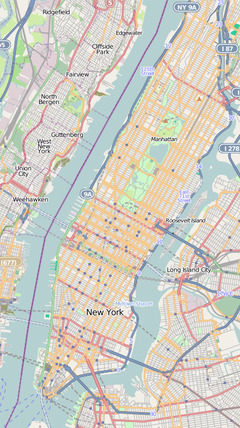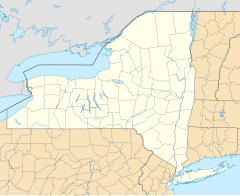50 West Street
| 50 West Street | |
|---|---|

Seen from a West Street pedestrian bridge in April 2017.
|
|
|
Location within Lower Manhattan
|
|
| General information | |
| Status | Complete |
| Type |
|
| Location | 50 West Street |
| Coordinates | 40°42′29″N 74°00′54″W / 40.70801°N 74.01505°WCoordinates: 40°42′29″N 74°00′54″W / 40.70801°N 74.01505°W |
| Groundbreaking | June 23, 2008 |
| Construction started | Fall 2013 |
| Topped-out | October 23, 2016 |
| Completed | 2017 |
| Cost | $600 million |
| Height | |
| Architectural | 778 ft (237 m) |
| Tip | 778 ft (237 m) |
| Observatory | 734 ft (224 m) |
| Technical details | |
| Floor count | 63 |
| Floor area | 53,883 m2 (580,000 sq ft) |
| Design and construction | |
| Architect | Murphy/Jahn Architects |
| Developer | Time Equities Inc. |
| Structural engineer | DeSimone Consulting Engineers |
| Main contractor | Hunter Roberts Construction Group |
| References | |
50 West Street is a 64-story, 778 ft (237 m) tall mixed-use retail and residential condominium tower developed by Time Equities Inc. in Lower Manhattan, New York City. It will contain 191 units.
The building is located on 50 West Street, in the Financial District neighborhood located at the southern tip of the borough of Manhattan in New York City. It is located 0.5 mi (805 m) via West Street from One World Trade Center. The site borders a high-rise rental building called 90 Washington to the north while being surrounded by a privately owned parking garage to the south and east of the structure.
The building is designed by architect Helmut Jahn, known for works such as the Messeturm in Frankfurt, CitySpire, the Park Avenue Tower and 425 Lexington Avenue in New York City. The tower of curved glass is supposed to provide panoramic views of New York Harbor. In order to achieve a possible Gold LEED rating, the building will include sustainable technologies, such as a green roof, water-efficient plumbing fixtures, automated blinds and energy control systems.
A total of 3,000 panels of glass were to be installed, with each pane weighing up to 1,900 pounds (860 kg), framed by aluminum, and braced by stainless steel panels that are made in Italy. Five hundred of them are curved, and can cost 300 to 500 percent more than flat glass. According to Jahn, no other building uses curved glass in such volume, from street level to penthouse level.
...
Wikipedia





